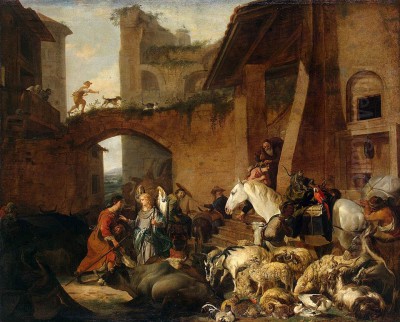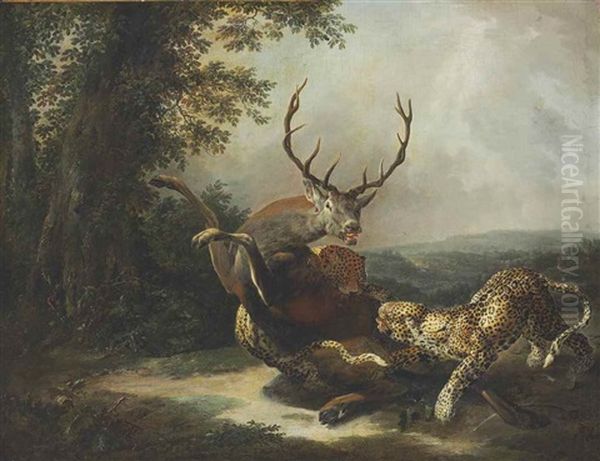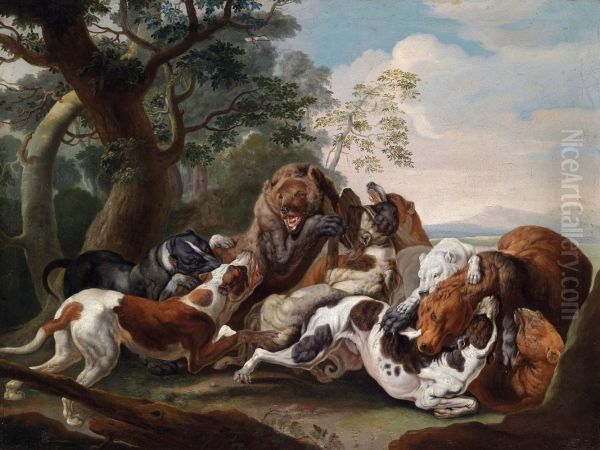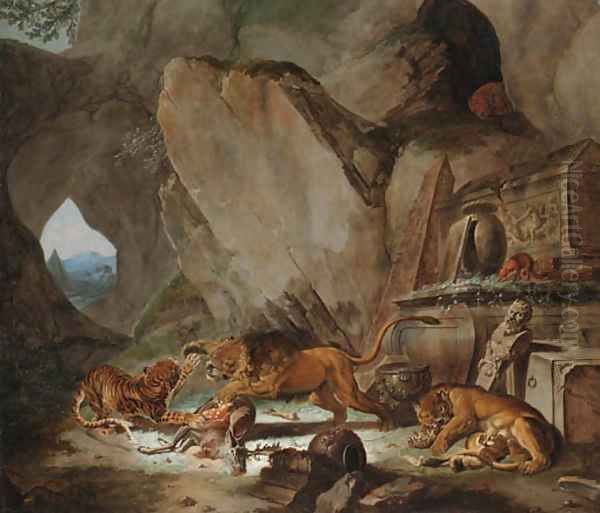
Carl Borromaus Andreas Ruthart stands as a significant figure in the landscape of 17th-century European art. Born in Danzig (modern-day Gdańsk, Poland) in 1630, his life and career unfolded across a remarkably broad geographical canvas, ultimately establishing him as one of the preeminent animal painters, or Tiermaler, of the Baroque era. His death in 1703 marks the end of a career characterized by meticulous observation, dynamic compositions, and a unique blend of naturalistic detail with dramatic, often allegorical or religious, themes.
Ruthart's specialization in depicting animals, particularly in scenes of hunting and combat, placed him within a popular and evolving genre. The Baroque period saw a surge in interest in the natural world, alongside the continuation of aristocratic pursuits like hunting, making his subject matter highly sought after. His ability to capture the raw energy, anatomical accuracy, and perceived emotions of animals set his work apart, earning him considerable acclaim during his lifetime and ensuring his legacy endured.
Despite his renown, aspects of Ruthart's life remain shrouded in some obscurity, a common challenge for historians studying artists from this period. Records can be sparse or conflicting. However, through his surviving works and the documented stages of his career journey – from Northern Europe to the heart of Italy – we can piece together a compelling portrait of an artist dedicated to capturing the vitality and ferocity of the animal world.
Early Life and Pan-European Journeys
Born into the bustling port city of Danzig, Ruthart's early artistic inclinations and training are not definitively documented. The city itself was a crossroads of cultures and trade, potentially exposing the young artist to various influences. However, concrete details about his formative years or initial instruction remain elusive. What is clear is that Ruthart embarked on a path that would take him far from his birthplace, immersing him in several major European art centers.

His travels were extensive for the time. Evidence places him in Antwerp around 1663 or 1664. This period was crucial, as Antwerp was a powerhouse of Flemish Baroque painting, particularly renowned for its animal and still-life specialists. Exposure to this vibrant scene undoubtedly played a significant role in honing his focus and skills in animal depiction. The legacy of masters like Peter Paul Rubens, whose workshop produced vast quantities of art including hunting scenes, still permeated the city's artistic atmosphere.
Following his time in the Low Countries, Ruthart's journey continued through various German-speaking lands. He is documented as having worked in Regensburg, Berlin, and the imperial capital of Vienna between approximately 1665 and 1667. This itinerary suggests a search for patronage and opportunities, moving between significant political and cultural hubs. Each location would have offered different artistic encounters and potential commissions, broadening his experience and reputation.
Ultimately, Ruthart gravitated towards Italy, the epicenter of the Baroque art world. He spent considerable time in Rome, a city teeming with artists, patrons, and the overwhelming influence of both classical antiquity and contemporary masters like Gian Lorenzo Bernini and Pietro da Cortona. He also worked in Venice, another major artistic center with its own distinct traditions, particularly regarding color and light, perhaps encountering the works of late Renaissance Venetian masters or contemporary painters. His final years were spent further south.
Artistic Development and Influences
While Ruthart reportedly described himself as "self-taught," this likely signifies a lack of formal apprenticeship under a single famous master rather than a complete absence of learning from others. His time in Antwerp, in particular, strongly suggests exposure to, and absorption of, Flemish artistic traditions. The detailed realism, dynamic compositions, and often dramatic subject matter seen in Flemish animal painting are clearly reflected in Ruthart's own work.
The influence of Frans Snyders (1579-1657), a leading Flemish painter of animals, hunting scenes, and market stalls, is often noted in discussions of Ruthart's style. Snyders, a collaborator of Rubens, was celebrated for his energetic depictions of animal combat and lavish still-lifes featuring game. Ruthart's own focus on similar themes, particularly the visceral struggles between predators and prey or hounds and game, echoes Snyders' powerful compositions.

Other Flemish artists specializing in similar genres, such as Jan Fyt (1611-1661), known for his refined depictions of hunting trophies and live animals, or Paul de Vos (c. 1591/92 or 1595–1678), another painter of large-scale hunts and animal fights, represent the rich artistic milieu Ruthart encountered. While direct tutelage isn't confirmed, the stylistic affinities suggest Ruthart was keenly observant of, and responsive to, the works of these Flemish masters during his stay in Antwerp.
Furthermore, his time in Italy would have exposed him to different approaches. The dramatic landscapes and sometimes turbulent scenes of Salvator Rosa (1615-1673), active primarily in Naples and Rome, might have offered a different kind of inspiration for integrating animals into wild, untamed settings. Although Ruthart's primary focus remained the animals themselves, the settings often contribute significantly to the mood of his paintings. The Dutch tradition, with painters like Paulus Potter (1625-1654) focusing on detailed and peaceful depictions of livestock in landscapes, provides a contrast but highlights the diverse ways animals were being represented in 17th-century art.
There is also mention of a possible, though unconfirmed, connection to the Flemish artist Pieter Boel (1622-1674). Boel, who also worked in Italy (Genoa and Rome) and was known for his animal studies and still-lifes, moved in similar circles geographically and thematically. Further research might clarify the nature of any potential relationship, whether it was one of direct contact, shared influence, or simply parallel development within the same genre.
Mastery of Animal Painting
Ruthart's reputation rests firmly on his exceptional ability as an animal painter. He possessed a profound understanding of animal anatomy, which allowed him to depict creatures with convincing structure and musculature. This anatomical accuracy was coupled with a remarkable skill in rendering textures – the coarseness of a stag's hide, the sleekness of a hunting dog's coat, the softness of fur, the sharpness of claws and teeth.
His works often focus on moments of intense action and drama. Hunting scenes were a staple, capturing the ferocity of hounds bringing down deer or boar. These compositions are typically dynamic, filled with diagonal lines and energetic poses that convey the speed and violence of the chase. Heroic Struggle of Hounds and Stag (or similar titles referring to this theme) exemplifies this aspect of his work, showcasing his ability to orchestrate complex multi-figure compositions involving animals in conflict.

Beyond the hunt, Ruthart explored other forms of animal interaction, often depicting predators and prey in dramatic confrontations. Works like Cheetah and Fox (or similar titles involving large cats) highlight his interest in exotic animals as well, creatures that held a particular fascination during the Baroque era. These paintings allowed him to explore themes of natural hierarchy, survival, and the inherent wildness of the animal kingdom.
His meticulous attention to detail extended beyond the animals themselves to their surrounding environments. Landscapes, though often secondary to the animal subjects, are rendered with care, providing appropriate settings that enhance the narrative and mood, whether it be a dense forest floor or a more open, rugged terrain. This integration of figure and setting contributes to the overall naturalism and impact of his paintings.
Ruthart also demonstrated versatility by incorporating his animal painting skills into biblical narratives. A notable example is Adam Naming the Animals. This subject, drawn from the Book of Genesis, provided a perfect opportunity for the artist to display his prowess in depicting a wide variety of creatures – domestic and wild, large and small – gathered peacefully in the Garden of Eden. Such works allowed him to combine his specialized talent with grander religious themes, appealing to a different facet of Baroque taste.
The Roman Period and Religious Life
After his extensive travels, Ruthart eventually settled in Italy. Rome, as the center of the Catholic Church and a major hub for artistic patronage, likely offered significant opportunities. His presence there placed him in the midst of the High Baroque, though his specialization remained distinct from the large-scale fresco cycles and dramatic religious altarpieces that characterized the work of many leading Italian contemporaries.
A significant turning point in Ruthart's life occurred in 1672 when he joined the Celestine Order, a monastic branch of the Benedictines. He entered a monastery, likely San Settimiano mentioned in some sources, or perhaps another Celestine house, eventually spending his later years in a monastery in L'Aquila, in the Abruzzo region of southern Italy. Taking holy orders marked a profound shift in his personal life, and it also influenced his artistic output.
As Fra Andrea, his monastic name, Ruthart continued to paint. However, his focus naturally shifted more towards religious subjects demanded by his new context. He is known to have contributed to the decoration of ecclesiastical spaces. For instance, he reportedly painted frescoes for the choir area of the Church of Sant'Eusebio in Rome, a church with ancient origins that underwent Baroque renovations. This commission demonstrates that his artistic skills remained valued even after entering the monastery.
While his thematic focus may have broadened to include more explicitly religious scenes, his fundamental interest and skill in depicting animals did not vanish. Animals continued to appear in his works, perhaps now imbued with greater symbolic or allegorical meaning within religious contexts. The discipline and contemplative life of the monastery may have offered a different perspective on the natural world he had so keenly observed and depicted throughout his secular career. His decision mirrors, in a way, earlier artists like Fra Angelico or Lorenzo Monaco who combined monastic life with artistic creation, though Ruthart's specialization remained unique.
His later life, spent within the structure of the Celestine Order until his death in 1703, adds a fascinating dimension to his biography. It represents a convergence of artistic dedication and spiritual commitment, a path not uncommon in the history of art but particularly notable for an artist who had achieved significant recognition in the competitive secular art markets of Europe.
Legacy and Collections
Carl Borromaus Andreas Ruthart secured his place as one of the most accomplished animal painters of the 17th century. His work was highly regarded during his lifetime, sought after by collectors who appreciated his technical skill and the dramatic intensity of his subjects. The enduring appeal of hunting and animal themes, particularly among aristocratic patrons in Northern Europe and England, ensured a market for his specialized output.
His paintings entered various collections over the centuries. Notably, works have been associated with the Ferini family collection. Today, his paintings can be found in museums and private collections across Europe and North America. The Speed Art Museum in Louisville, Kentucky, for example, holds his significant work Adam Naming the Animals, acquired through a donation, highlighting the continued appreciation for his art far beyond his original geographical sphere.
Ruthart's influence extended to subsequent generations of artists specializing in animal painting. While the provided sources indicate no known direct students or apprentices who carried on his specific workshop traditions, his work contributed to the high standard and popularity of the genre. Later artists in the 18th century, such as the French painter Jean-Baptiste Oudry (1686-1755), who became famous for his royal hunting scenes and animal studies, or even the English master George Stubbs (1724-1806), renowned for his anatomical precision in depicting horses, built upon the foundations laid by Baroque animal specialists like Ruthart.
The relative scarcity of detailed biographical information presents challenges for fully understanding Ruthart's life and connections. The potential link to Pieter Boel remains an area for further art historical investigation. However, the quality and distinctiveness of his surviving oeuvre speak volumes. He successfully navigated the diverse artistic landscapes of Europe, adapted his skills to different contexts – from secular patronage to monastic service – and left behind a body of work celebrated for its dynamic portrayal of the animal kingdom.
Conclusion
Carl Borromaus Andreas Ruthart's career exemplifies the mobility and adaptability of artists during the Baroque period. From his origins in Danzig, his path led him through the major art centers of Antwerp, Vienna, Rome, and Venice, absorbing influences and building a reputation as a master of animal painting. His specialization in scenes of the hunt and animal combat resonated with contemporary tastes, while his technical proficiency in capturing anatomy, texture, and movement set his work apart.
His later decision to enter the Celestine Order adds a layer of complexity to his story, demonstrating a commitment that transcended purely artistic ambition. Even within the monastic context, his artistic talents remained active, adapting to new thematic demands while retaining the core skills honed over decades. Though perhaps less famous today than some of his contemporaries who focused on large-scale history painting or portraiture, Ruthart's contribution to the specific and demanding genre of animal painting was substantial.
His works, characterized by their energy, detail, and often dramatic intensity, continue to be appreciated in collections worldwide. They offer a vivid window into the Baroque fascination with the natural world, the aristocratic culture of the hunt, and the enduring power of animals as artistic subjects. Carl Borromaus Andreas Ruthart remains a key figure for understanding the development and richness of 17th-century animal painting in Europe.